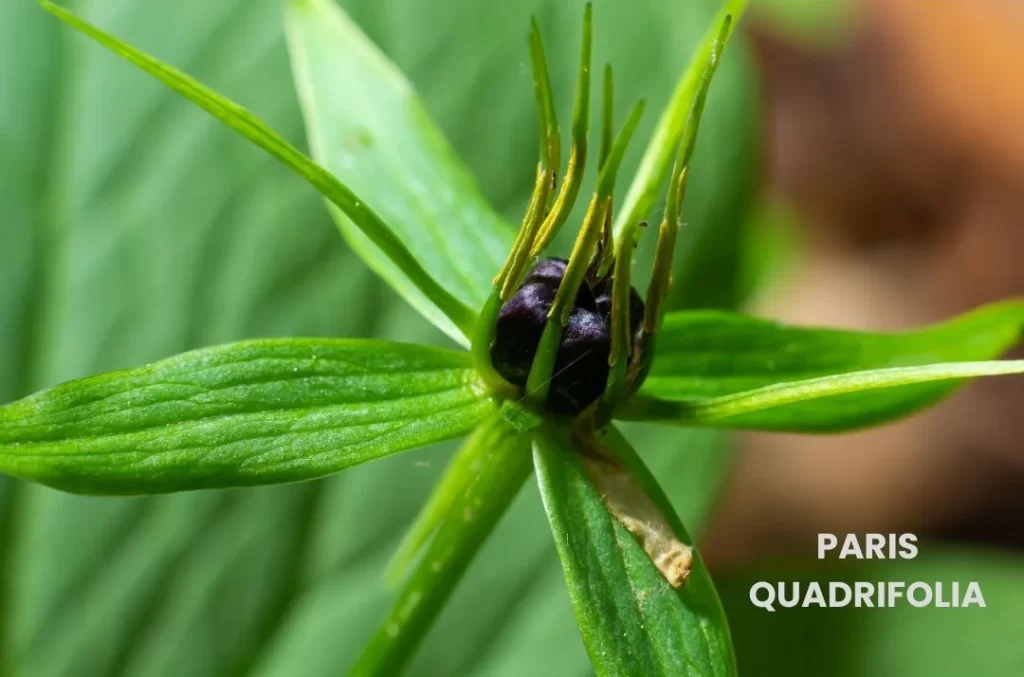Paris Quadrifolia, commonly known as One-berry, is a homeopathic remedy derived from a plant in the Melanthiaceae family.
It is well-known for its marked head symptoms, catarrhal complaints, and a distinct sensation of bodily asymmetry, with coldness on one side and heat on the other.

Table of Contents
ToggleSOURCE INFORMATION
Scientific Classification
- Kingdom: Plantae
- Order: Liliales
- Family: Melanthiaceae
- Genus: Paris
- Species: P. quadrifolia
ORIGIN AND HISTORICAL FACTS
- Origin: Paris Quadrifolia is native to Europe and parts of Asia, typically found in shady, damp woods and hedgerows.
- Historical Usage: Historically, the plant has been used in traditional medicine for its analgesic and anti-inflammatory properties.
- It was often employed to treat neuralgia, headaches, and other pain-related conditions.
- Medicinal Uses: In homeopathy, Paris Quadrifolia is used primarily for its action on the nervous system, particularly in treating conditions involving neuralgic pains and sensations of tension and expansion in the head.
DRUG PATHOGENESIS
- Paris Quadrifolia primarily acts on the nervous system, causing symptoms of tension, expansion, and neuralgia.
- It affects the head, eyes, face, respiratory system, and extremities, providing relief from various forms of pain and discomfort.
KEY CHARACTERISTICS
- Head: Sensation of expansion and tension; coldness on the right side of the body while the left side is hot.
- Catarrhal Complaints: Stuffed feeling at the root of the nose.
- Disordered Sense of Touch: Feelings of numbness and altered sensation.
DETAILED ORGAN SYMPTOMS
MIND
- Imaginary Foul Smells: Patient perceives non-existent bad odours.
- Sense of Enlargement: Feels as though the body or parts of it are too large.
- Garrulousness: Excessive talking, prattling, and vivacious behavior.
HEAD
- Scalp Sensation: Feeling as if the scalp were contracted and bones scraped.
- Soreness: Top of the head is sore, making it difficult to brush hair.
- Headaches: Aching sensation from pulling a string from the eyes to the occiput, and occipital headache with a feeling of weight. The head feels very large and expanded. Numbness on the left side of the head.
EYES
- Heavy Eyes: Feels as though the eyes are heavy and projected outward.
- String Sensation: Sensation of a string running through the eyeballs, causing an expanded feeling, as though the eyelids do not cover the eyes properly.
FACE
- Neuralgia: Hot stitches and soreness in the left malar bone.
- Relief noted in inflammation of the antrum, particularly when eye symptoms are present.
MOUTH
- Dry Tongue: Tongue feels dry upon waking.
- Coated Tongue: White coating on the tongue without thirst, often accompanied by a bitter or diminished taste.
RESPIRATORY
- Fullness at Root of Nose: A stuffed and full sensation.
- Hoarseness: Periodical, painless hoarseness.
- Cough: Persistent cough as if from inhaling sulfur vapor, with constant hawking due to viscid, green mucus in the larynx and trachea.
EXTREMITIES
- Weight and Weariness: Sense of weight and weariness in the nape of the neck and across the shoulders.
- Neuralgia: Pain beginning in the left intercostal region, extending into the left arm, causing stiffness and clenched fingers.
- Coccyx Pain: Pulsating, sticking pain when sitting.
- Numbness: Numbness of the upper limbs and fingers, with everything feeling rough.
MODALITIES
- Aggravation: Symptoms may be aggravated by cold air and touch.
- Amelioration: Symptoms improve with warmth and rest.
WHAT ARE MODALITIES IN HOMOEOPATHY?
RELATIONSHIP WITH OTHER DRUGS
Compare
- Pastinaca (Parsnip): Used for symptoms like loquacity (excessive talking), delirium tremens (severe alcohol withdrawal), illusions of vision, and intolerance to milk.
- The roots are used dietetically, cooked in water or as broth or salad, particularly for consumptive patients and those with kidney stones.
- Silicea (Sil): Often used for chronic conditions involving the skin, bones, and immune system.
- Calcarea Carbonica (Calc): A remedy for a wide range of conditions, particularly those involving the bones and teeth, and for patients with a tendency to obesity.
- Nux Vomica (Nux): Commonly used for digestive disorders, headaches, and irritability.
- Rhus Toxicodendron (Rhus): Typically used for conditions that worsen with rest and improve with movement, such as arthritis and skin issues.
Incompatible: Ferrum Phosphoricum (Ferr phos)
Antidote: Coffea Cruda (Coff)
DOSE
- Potency: Typically used in the third potency (3C), depending on the patient’s symptoms and response to treatment.
Frequently Asked Questions
What is Paris Quadrifolia used for?
- Paris Quadrifolia is used to treat neuralgic pains, sensations of expansion and tension in the head, catarrhal complaints, and disorders of the sense of touch.
Is Paris Quadrifolia safe to use?
- When used in recommended homeopathic potencies, Paris Quadrifolia is generally safe.
- However, it is advisable to consult with a qualified homeopathic practitioner for proper dosage and administration.
Glossary of Difficult Words
- Neuralgia: Intense, typically intermittent pain along the course of a nerve, especially in the head or face.
- Catarrhal: Inflammation of a mucous membrane with increased production of mucus, particularly in the nose and throat.
- Occiput: The back part of the skull.
- Malar Bone: The cheekbone.
- Antrum: A natural cavity or chamber within a bone or other tissue, particularly in the face (maxillary sinus).
- Hypochondrium: The upper part of the abdomen on either side of the epigastrium, below the cartilages of the lower ribs.
Paris Quadrifolia is a versatile homeopathic remedy with a range of applications for neuralgic and catarrhal conditions, particularly effective in treating head and respiratory symptoms.
